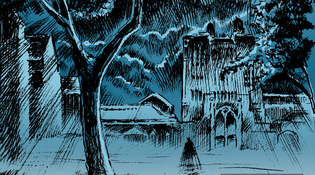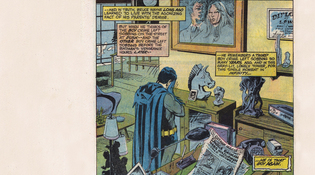 loading
loading
featuresHoly Eli, Batman!A secret—known only to a few . . . hidden—like his true identity, for many years . . . stands revealed!
Chip Kidd, a graphic designer and author, has taught many design workshops at the Yale School of Art. His first novel, The Cheese Monkeys, was a national bestseller and a New York Times Notable Book of the Year.  Lee SullivanView full image
I initially met the theory that Batman went to Yale with what can only be called powerful skepticism. As something of a professional fan of the Dark Knight (I know, I know, at my age that sounds pathetic—but by now I’ve produced three authorized books on the character and have a full-length Batman graphic novel in the works), I had never heard this. Superheroes tend be associated with cities rather than schools: Metropolis (Superman), Central City (The Flash), New York (Spider-man, the X-Men, and many of the other Marvel characters), and in the case of the Caped Crusader, Gotham. When higher learning does come into play, it’s usually relegated (rather unimaginatively) to the colleges named for the cities. Thus, when Robin finally came of age in the comics in the late 1960s and was allowed to go away to school, he went to Gotham University. Young Clark Kent went to Metropolis U. But back to the subject at hand: the idea that Bruce Wayne is an Eli is backed up by two pieces of intriguing “evidence.” The first chronologically is a short 1966 video clip from the 33rd episode of the Batman TV show that starred Adam West. (It is readily accessible on YouTube; run a search on “Batman Skull and Bones.”) We see a party going on in the living room at Wayne Manor. A distinguished-looking gentleman of a certain age gestures to a portrait on the wall above the couch and asks Aunt Harriet: “And that is Bruce Wayne’s grandfather, Mrs. Cooper?” “His great-grandfather,” she replies. The picture is a painting of a handsome young man wearing a white football jersey with a large navy blue “Y” on the front. The gentleman continues: “I understand he was tapped for Skull and Bones.” Aunt Harriet snaps right back: “Tapped for it? Sir, he founded Skull and Bones.” So there you have it: the Wayne/Yale legacy not only reaches back three generations, it also spawned the university’s most prestigious and notorious secret society. (For the record, Skull and Bones was actually founded in 1832 by William H. Russell ’33 and Alphonso Taft ’33.) This is a rather neat conceit when you think about it. The implication is that it’s in the nature of the Wayne men to create a unique identity for themselves that is both public and yet fiercely private. For what is “Batman and Robin” but the ultimate secret society, with only two members? Nevertheless, for true Bat-geeks, this evidence of Batman’s connection with Yale is largely meaningless. Why? Because it’s the Batman TV show from 1966. Allow me to explain. The conventional wisdom among fans is that this program saved Batman as a commercial property but also doomed him, as a character, to decades of mainstream ridicule. The show was a last-ditch effort to jumpstart Batman’s popularity in the comics, which had become negligible, and it accomplished that beyond anyone’s expectations. But it did so by turning him into the ultimate costumed laughingstock—this for a character who, in the first year’s worth of stories, had been depicted as grim, demon-like, ruthless, and very much nocturnal. And a loner. (That was during 1939–40, inDetective Comics. Then the writers created Robin, and that changed everything. But I digress.) It would not be until 20-plus years after the TV show—with the one-two punch of Frank Miller’s Dark Knight comics series and Tim Burton’s first Batman film—that the character would be returned to his dark roots in the general public’s imagination. In short, it would be one thing if the comics had established Wayne as a Yale grad very early on and made it part of the mythology, and the TV series was just echoing that. But that’s not the case. As with so many of the program’s elements (the design of the Batmobile, many of the villains, the bust of Shakespeare that controls the entrance to the Batcave) the Skull and Bones connection was an invention of the show, specifically for that scene, and never referred to again. So let’s look at exhibit B. This is more intriguing. It is a detail of the last panel of a 14-page comic book story called “Night of the Stalker,” originally appearing in 1974 in Detective Comics #439. First of all, this is a great story, with writing by Steve Englehart and art by Sal Amendola and Dick Giordano. Its theme of existential despair (seriously) had quite the effect on the fourth-grade me. At the beginning, Batman is out on patrol on the Gotham City rooftops when he witnesses a bank robbery on the street below. In the midst of the thieves’ getaway, an innocent couple is murdered before the eyes of their young son—just as happened to the Waynes decades before. Batman, too late to stop the murders, pursues the fleeing perpetrators out of the city and into the surrounding woods. What follows is right out of Deliverance, as the terrified lowlifes are taken down (but not killed) one by one. At the end, when he returns to his study in Wayne Manor, Batman takes off his mask, and, overwhelmed by the seemingly unstoppable cycle of violence, he weeps. And here, we come to the heart of the question. In the background of this last panel, on the wall, is a framed document, a diploma. Using an extremely strong magnifying glass you can just barely make out that it’s from … the Yale Law School. I bow to the eagle-eyed sleuth who discovered it. I have re-read the story countless times over the years and never before noticed this tiny detail. So. Does this mean Batman went to Yale? Does it matter? It’s fun to imagine our fictional heroes inhabiting familiar haunts of our corporeal world, because it brings them that much closer to reality. More to the point, is Bruce Wayne a Yale candidate? He certainly fits the profile, on several levels. On the obvious side, he comes from wealth, both material and intellectual. His father was a doctor and one of Gotham’s most prominent philanthropists. The concept of Wayne studying law is more than a little ironic, as he spends his secret life working outside of it. But I think the real case to be made is Yale’s emphasis on community service. Because that is how he primarily sees himself—as an urban steward—and he would have been most taken upon graduation with the words spoken by Yale’s president: “By the authority vested in me, I confer upon you [these] degrees … and admit you to all their rights and responsibilities.” It is that word which so succinctly defines the Yale mission—“responsibilities,” both to one’s self and to society—that I think would have most inspired a young and impassioned Bruce Wayne.  Batman & DC ComicsIn this final page of "Night of the Stalker" (1974, story and drawings by Sal Amendola), the Yale law diploma is visible hanging on the wall. View full image
The comment period has expired.
|
|